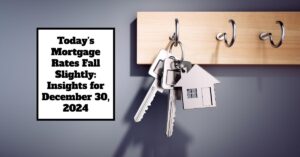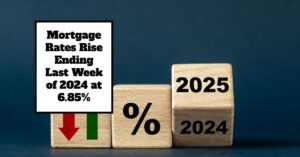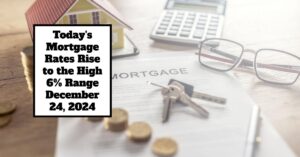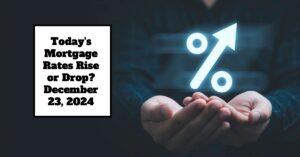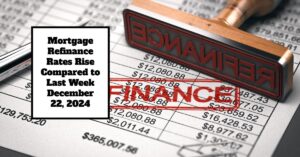When you're thinking about buying a home or refinancing your current mortgage, understanding today's mortgage rates is essential. Recently, mortgage rates have shown both signs of decrease and increase across various loan types. As of today, the 30-year fixed mortgage rate is at 6.72%, while the 15-year fixed has bumped up to 6.12%. These rates can significantly impact the overall cost of your mortgage, so it’s key to stay updated.
Today’s Mortgage Rates Fall Slightly: Insights for December 30, 2024
Key Takeaways
- Current mortgage rates: 30-year fixed: 6.72%, 15-year fixed: 6.12%.
- Rates have fluctuated, making it essential to monitor changes.
- Winter months are often a good time to buy, due to less competition.
- Future projections suggest gradual declines in mortgage rates could be possible in 2025.
- Adjustable-rate mortgages (ARMs) are currently lower than fixed rates but have risks.
Understanding mortgage rates can feel complex, but breaking it down can help you see the bigger picture. In today’s market, mortgage rates are in a state of fluctuation. According to Zillow's data, while some rates, like the 30-year fixed mortgage, have decreased slightly, others—like the 15-year fixed have gone up. This duality of movement is something buyers should keep in mind when making their decisions.
Current Mortgage Rates Overview
As of today, here are the national average mortgage rates:
| Loan Type | Current Rate |
|---|---|
| 30-year fixed | 6.72% |
| 20-year fixed | 6.55% |
| 15-year fixed | 6.12% |
| 5/1 ARM | 6.73% |
| 7/1 ARM | 6.54% |
| 30-year VA | 6.15% |
| 15-year VA | 5.66% |
| 5/1 VA | 6.38% |
These rates are rounded to the nearest hundredth and represent national averages.
Refinance Rates Today
If you are considering refinancing, be mindful that the rates can be slightly higher:
| Refinance Type | Current Refinance Rate |
|---|---|
| 30-year fixed | 6.70% |
| 20-year fixed | 6.53% |
| 15-year fixed | 5.99% |
| 5/1 ARM | 6.05% |
| 7/1 ARM | 6.70% |
| 30-year VA | 6.04% |
| 15-year VA | 5.83% |
| 5/1 VA | 5.84% |
Recommended Read:
Mortgage Rate Predictions January 2025: Forecast for Homebuyers
Understanding Mortgage Types
When discussing today's mortgage rates, it's essential to recognize the different types of mortgages available:
30-Year Fixed Mortgage
The 30-year fixed mortgage remains the most popular type in the United States. With an average rate of 6.72%, this mortgage allows you to spread out payments over 360 months, making monthly costs more manageable.
For instance, if you take a $300,000 mortgage with a 30-year fixed rate of 6.72%, your estimated monthly payment would be $1,940. Over the loan's lifespan, you would end up paying around $398,334 in interest.
15-Year Fixed Mortgage
On the other hand, a 15-year fixed mortgage typically offers a lower interest rate of 6.12%. It allows homeowners to pay off their loans quicker but comes with higher monthly payments.
For example, again on a $300,000 mortgage, your monthly payment would be about $2,551, and the total interest paid over the life of the loan would drop dramatically to about $159,191. Many homeowners choose this option to save money on interest.
Adjustable-Rate Mortgages (ARMs)
Adjustable-rate mortgages, like the 5/1 ARM, typically start with lower rates—which is currently 6.73%. However, after the initial fixed period (in this case, five years), the rate can fluctuate yearly based on market conditions. This might be a smart option if you plan to sell your home before the rate adjusts.
Realizing that an ARM can potentially save money in the short term is vital, but it comes with the uncertainty of future payments. Thus, careful financial planning is essential if you choose this route.
Factors Influencing Mortgage Rates
The mortgage rates we see today are influenced by various factors, including:
- Economic Indicators: Economic stability or fluctuations can raise or lower rates significantly.
- Inflation Rates: Higher inflation usually leads to higher interest rates, as lenders want to protect their return against decreasing currency value.
- Federal Reserve Policy: Changes in monetary policy, such as adjustments to the federal funds rate, can indirectly affect mortgage rates. When the Fed raises rates, other borrowing costs typically increase as well.
- Housing Market Trends: Supply, demand, and even seasonal trends can lead to rate changes. A booming market might see higher rates due to increased demand, while a slow market may see lowered rates to entice buyers.
- Lender Competition: Different lenders may offer varied rates based on how they assess risk and competition in their local markets.
Where are Rates Headed? Future Projections
While mortgage rates have fluctuated recently, many analysts predict slow decreases in the coming year. A recent report from Fannie Mae predicts that the 30-year fixed rate will drop to 6.20% by the end of 2025.
Market experts suggest that borrowers should expect rates in the 6% to 7% range for some time, especially in early 2025. Gradual decline in rates can be beneficial for buyers as the housing market adjusts to economic conditions (Yahoo Finance, 2024).
Another important point to consider is that today’s lower inventory levels, common during winter months, can create less buyer competition. This often leads to better deals for those shopping for homes right now.
Key Determinants of Mortgage Rates
To further understand how mortgage rates are determined, multiple external and personal factors come into play:
- Credit Score: One of the most significant factors affecting your mortgage rate is your credit score. Higher scores typically lead to lower rates. Lenders see individuals with strong credit histories as less risky.
- Down Payment: A larger down payment not only reduces the amount financed but also lowers the risk for lenders, often resulting in a lower interest rate.
- Loan Amount and Type: Larger loan amounts tend to have different rate structures compared to smaller loans. Certain types of loans, such as government-backed loans (FHA, VA), may offer more favorable rates.
- Loan Term: Shorter loan terms (like 15 years) often come with lower rates compared to longer terms (like 30 years). Borrowers willing to commit to more substantial monthly payments usually benefit from lower overall costs.
- Economic Factors: As previously mentioned, factors like inflation, employment rates, and overall economic health play critical roles in determining mortgage rates.
- Market Conditions: The broader bond market, particularly the yields on the 10-year Treasury note, closely monitors trends and responds to investor demand, influencing mortgage pricing.
Understanding how these factors interplay can empower potential homeowners or those looking to refinance to navigate their choices better.
Current Trends and Advice for Buyers
If you are contemplating entering the housing market now, it’s crucial to consider these insights. With today's mortgage rates hovering at averages potentially peaking between 6% and 7%, aligning your financial strategies becomes essential.
- As noted previously, interest rates today reflect both volatility and opportunity. The national averages are simply a starting point. Rates may vary depending on your unique financial profile, lender policies, and even the specifics of the area where you intend to buy.
- If you're looking to refinance your current mortgage, it’s a good time to compare several lenders to pinpoint the best deal. Even a small difference in interest rates can save you thousands over the life of your loan.
- Lastly, remember the impact of seasonality in home buying. With fewer buyers looking in colder months, you might find better pricing on homes and additional leverage in negotiations.
Conclusion: What Lies Ahead?
Navigating the waters of today's mortgage rates requires careful consideration and awareness of all variables involved. With recent data indicating both dips and spikes in rates, it's more important than ever to stay informed and prepared.
The housing market continues to evolve, and while the rates today might not reflect the lowest on record, the overall environment can present significant opportunities for the right buyer. As we look to 2025, gradual decreases in rates could invite more activity, making it an interesting space to watch.
Work with Norada in 2025, Your Trusted Source for
Turnkey Investment Properties
Discover high-quality, ready-to-rent properties designed to deliver consistent returns.
Contact us today to expand your real estate portfolio with confidence.
Contact our investment counselors (No Obligation):
(800) 611-3060
Recommended Read:
- NAR Predicts 6% Mortgage Rates in 2025 Will Boost Housing Market
- Mortgage Rates Predictions for 2025: Expert Forecast
- Half of Recent Home Buyers Got Mortgage Rates Below 5%
- Mortgage Rates Need to Drop by 2% Before Buying Spree Begins
- Will Mortgage Rates Ever Be 3% Again: Future Outlook
- Mortgage Rates Predictions for Next 2 Years
- Mortgage Rate Predictions for Next 5 Years
- Mortgage Rate Predictions for 2025: Expert Forecast
- Prediction: Interest Rates Falling Below 6% Will Explode the Housing Market
- Mortgage Rate Predictions: Why 2% and 3% Rates are Out of Reach
- How Lower Mortgage Rates Can Save You Thousands?
- How to Get a Low Mortgage Interest Rate?
- Will Mortgage Rates Ever Be 4% Again?
